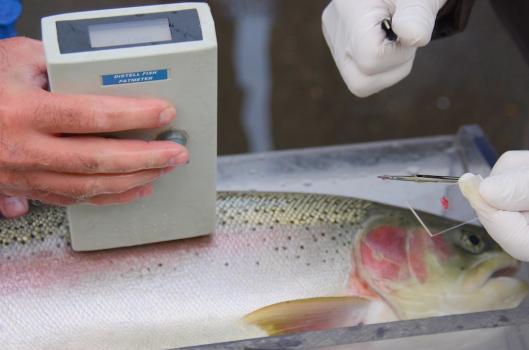forum
library
tutorial
contact

Air-Spawned Steelhead
Trout Release, an Inside Look
by Jack McNeel
Indian Country, October 25, 2013
|
the film forum library tutorial contact |

|
Air-Spawned Steelhead
by Jack McNeel
|
 The steelhead's moment of truth arrived as a team of biologists gathered at the Dworshak Hatchery.
The steelhead's moment of truth arrived as a team of biologists gathered at the Dworshak Hatchery.
It was early October, and adult steelhead trout had been held in covered tanks for upwards of seven months, fish that had spawned the previous year. Today was their day to be returned to the river, to a wild state, hopefully to reproduce for a second time -- a rare occurrence nowadays but one that is essential to keeping the species going.
If humans had not interfered by building dams to create huge reservoirs, these fish would go back to the ocean and return later to spawn a second time. But fewer than two percent can now make that second return because of the dams and slack water. The tribes' hope is that these so-called reconditioned fish -- engineered for reproduction sans the ocean trip -- can help rebuild the population and eventually lead to the species' removal from the threatened category.
During their months in the tank, the kelts were fed a healthy diet to restore their strength. Salt has been added daily to the tank to simulate ocean water. The fish are both a saltwater and freshwater species, and the salt both calms them down and thickens the protective slime shield that coats their bodies, explained Nez Perce tribal member Noah Jackson.
But first the biologists had to conduct some tests. Jackson climbed into the tank to net the steelhead before they were carried to a large vat filled with aquiS, commonly called clove oil, to knock them out for a short while. Other people stood by to weigh and measure each fish. Blood samples were taken to measure the levels of estrodial, to determine whether the fish were mature enough to reproduce. Some steelhead mature in the ocean in one year, while others take two. The managers here wanted to see if that was also happening in the reconditioned fish.
A swab was taken from the gills for a virus screen test. Gastric radio tags were inserted through the mouth to the back of the esophagus, a process that takes just a couple of seconds. The tags will emit a pulse every five or six seconds so that researchers can track the fish throughout the Clearwater to find out where these kelts go.
By this time the fish were recovering from the aquiS, so were then moved to a tank in a truck to for transport to a release site a few miles upstream from the Dworshak Hatchery at Orofino, Idaho. They were checked again to make sure the transmitters were properly installed and were giving off beeps that monitors can detect.
Fish by fish, they were carried in nets to the riverbank and gently released into the cool waters of the Clearwater River. No encouragement was needed to get them back into the water, and in a second or two they had wriggled out of sight, though not out of mind.
"They all have PIT-tags, so we're able to track them as they go through the main-stem dams," said Scott Everett, who heads up this kelt project for the Nez Perce Tribe. "There are also PIT-tag arrays all over the upper tributaries that detect these steelhead. We also have radio tracking. There are people who drive up and down the road and in boats, actively tracking those radio tags as well as fixed stations up and down the river."
A lot of time and manpower is invested in these kelts, but if the practice leads to increased populations and removal of the species' threatened status, said Everett, it would be well worth the effort. Preliminary indications are that it's paying off.
"We're hoping to get at least 180 fish to return into the Clearwater from our reconditioning," Everett said. "This year we're going to release between sixty and seventy fish so we're a ways away from that sixty percent but we're slowly increasing our numbers every year."
learn more on topics covered in the film
see the video
read the script
learn the songs
discussion forum
